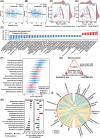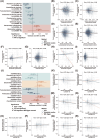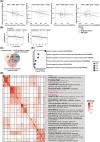Microbial metabolism mediates the deteriorative effects of sedentary behaviour on insulin resistance
- PMID: 40413611
- PMCID: PMC12103651
- DOI: 10.1002/ctm2.70348
Microbial metabolism mediates the deteriorative effects of sedentary behaviour on insulin resistance
Abstract
Background: Prolonged sedentary time is a strong risk factor for insulin resistance. Recent evidence indicates that gut microbiota may influence the regulation of insulin sensitivity and demonstrates a distinct profile between sedentary and physically active individuals. However, whether and how microbial metabolism mediates the progression of insulin resistance induced by prolonged sedentary time remains unclear.
Methods: 560 male participants without hypoglycaemic therapy were included, and insulin resistance was evaluated using the Homeostatic Model Assessment of Insulin Resistance (HOMA-IR). The gut microbiota was identified through metagenomics, host genetic data were obtained using a genotyping array, and plasma metabolites were quantified by liquid chromatography mass spectrometry.
Results: A panel of 15 sedentary-related species and 38 sedentary-associated metabolic capacities accounted for 31.68% and 21.48% of the sedentary time-related variation in HOMA-IR, respectively. Specifically, decreased Roseburia sp. CAG:471, Intestinibacter bartlettii, and Firmicutes bacterium CAG:83, but increased Bacteroides xylanisolvens related to longer sedentary time, were causally linked to the development of insulin resistance. Furthermore, integrative analysis with metabolomics identified reduced L-citrulline and L-serine, resulting from a suppression of arginine biosynthesis as key microbial effectors linking longer sedentary time to enhanced insulin resistance.
Conclusions: In summary, our findings provide insights into the mediating role of gut microbiota on the progression of insulin resistance induced by excessive sedentary time, and highlight the possibility of counteracting the detrimental effect of prolonged sedentary time on insulin resistance by microbiota-modifying interventions.
Key points: Prolonged sedentary time leads to a depletion of Roseburia sp. CAG:471 and Firmicutes bacterium CAG:83, and suppresses arginine biosynthesis. Decreased L-citrulline and L-serine function as key microbial effectors mediating the adverse effect of sedentary time on insulin sensitivity. Targeting gut microbiota holds promise to combat insulin resistance induced by excessive sedentary time.
Keywords: Mendelian randomisation; gut microbiota; insulin resistance; sedentary behaviour.
© 2025 The Author(s). Clinical and Translational Medicine published by John Wiley & Sons Australia, Ltd on behalf of Shanghai Institute of Clinical Bioinformatics.
Conflict of interest statement
The authors declare no conflicts of interest.
Figures






Similar articles
-
Gut microbial metabolism is linked to variations in circulating non-high density lipoprotein cholesterol.EBioMedicine. 2024 Jun;104:105150. doi: 10.1016/j.ebiom.2024.105150. Epub 2024 May 9. EBioMedicine. 2024. PMID: 38728837 Free PMC article.
-
Faecal microbial metabolites of proteolytic and saccharolytic fermentation in relation to degree of insulin resistance in adult individuals.Benef Microbes. 2021 Jun 15;12(3):259-266. doi: 10.3920/BM2020.0179. Epub 2021 Apr 21. Benef Microbes. 2021. PMID: 33880973
-
Characterization of gut microbial and metabolite alterations in faeces of Goto Kakizaki rats using metagenomic and untargeted metabolomic approach.World J Diabetes. 2023 Mar 15;14(3):255-270. doi: 10.4239/wjd.v14.i3.255. World J Diabetes. 2023. PMID: 37035219 Free PMC article.
-
Gut microbiota: an emerging target connecting polycystic ovarian syndrome and insulin resistance.Front Cell Infect Microbiol. 2025 Mar 11;15:1508893. doi: 10.3389/fcimb.2025.1508893. eCollection 2025. Front Cell Infect Microbiol. 2025. PMID: 40134784 Free PMC article. Review.
-
The association between sedentary behaviour, physical activity and type 2 diabetes markers: A systematic review of mixed analytic approaches.PLoS One. 2022 May 11;17(5):e0268289. doi: 10.1371/journal.pone.0268289. eCollection 2022. PLoS One. 2022. PMID: 35544519 Free PMC article.
References
-
- Dempsey PC, Larsen RN, Winkler EAH, Owen N, Kingwell BA, Dunstan DW. Prolonged uninterrupted sitting elevates postprandial hyperglycaemia proportional to degree of insulin resistance. Diabetes Obes Metab. 2018;20:1526‐1530. - PubMed
MeSH terms
Grants and funding
- 2023YFC3606300/National Key Research and Development Program of China
- 82330105/Key Project of National Natural Science Foundation of China
- Overseas/Distinguished Young Scholars of the National Natural Science Foundation of China
- 21HAA01094/Distinguished Young Scholars of the National Natural Science Foundation of China
- 2024A04J6477/Guangzhou Science and Technology Project
LinkOut - more resources
Full Text Sources
Medical
